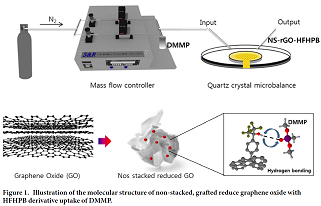
Hyoyoung Lee
Sungkyunkwan University, South Korea
Title: Graphene flake and graphene quantum dot-receptor sensor for detecting nerve agents
Biography
Biography: Hyoyoung Lee
Abstract
A novel gas sensor consisting of porous, non-stacked reduced graphene oxide (NSrGO)-heaxfluorohydoroxypropanyl benzene (HFHPB) nanosheets was successfully fabricated, allowing the detection of dimethyl methyl phosphonate (DMMP), similar to sarin toxic gas. The HFHPB group was chemically grafted to the NSrGO via a diazotization reaction to produce NSrGO-HFHPB. The NSrGO-HFHPB 3D film has a mesoporous structure with a large pore volume and high surface area that can sensitively detect DMMP and concurrently selectively signal the DMMP through the chemically-attached HFHPB. The DMMP uptake of the mesoporous NSrGO-HFHPB was 240.03 Hz, 12 times greater than that of rGO-HFHPB (20.14 Hz). In addition, the response rate of NSrGO-HFHPB was faster than that of rGO-HFHPB, an approximately 3 times more rapid recovery due to the mesoporous structure of the NSrGO-HFHPB. In addition we like to present a band gap tuning of environmental-friendly graphene quantum dot (GQD) for a photoluminescence (PL) sensor. With the help of the electron withdrawing HFHPB group, the energy band gap of the HFHPB-GQD was widened and its PL decay life time decreased. As designed, after addition of dimethyl methylphosphonate (DMMP), the PL intensity of HFHPB-GQD sensor sharply increased up to approximately 200% through a hydrogen bond with DMMP. The fast response and short recovery time was proven by quartz crystal microbalance (QCM) analysis. This HFHPB-GQD sensor shows highly sensitivity to DMMP in comparison with GQD sensor without HFHPB and graphene. In addition, the HFHPB-GQD sensor showed high selectivity only to the phosphonate functional group among many other analytes and also stable enough for real device applications. Thus, the tuning of the band gap of the photo-luminescent GQDs may open up new promising strategies for the molecular detection of target substrates.

Recent Publications
1. Keunsik Lee, Hanleem Lee, Yonghun Shin, Yeoheung Yoon, Doyoung Kim and Hyoyoung Lee* (2016) Tunable Sub-nanopore of Graphene Flake Interlayers with Conductive Molecular Linkers for Supercapacitors. ACS Nano 10:6799−6807.
2. Hee Min Hwang, Eunhee Hwang, Doyoung Kim & Hyoyoung Lee* (2016) Mesoporous Non-stacked Graphene-receptor Sensor for Detecting Nerve Agents. Scientific reports 6:33299.
3. Yonghun Shin, Junghyun Lee, Junghee Yang, Jintaek Park, Keunsik Lee, Sungjin Kim, Younghun Park and Hyoyoung Lee* (2014) Mass Production of Graphene Quantum Dots by One- Pot Synthesis Directly from Graphite in High Yield. Small 10:866–870.
4. Keunsik Lee, Hanleem Lee, Yonghun Shin, Yeoheung Yoon, Doyoung Kim and Hyoyoung Lee* (2016) Highly Transparent and Flexible Supercapacitors Using Graphene-Graphene Quantum Dots Chelate. Nano Energy 26:746-754.
5. Eunhee Hwang, Hee Min Hwang, Yonghun Shin, Yeoheung Yoon, Hanleem Lee, Junghee Yang, Sora Bak and Hyoyoung Lee* (2016) Chemically modulated graphene quantum dot for tuning the photoluminescence as novel sensory probe. Scientific Reports 6: 39448.

